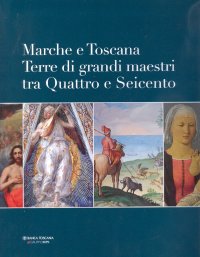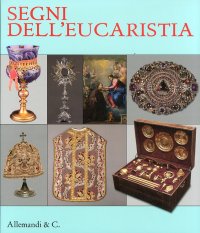Beato Angelico
Firenze, Palazzo Strozzi, September 26, 2025 - January 25, 2026.
Edited by Carl Brandon Strehlke.
Testi di Stefano Casciu, Marco Mozzo, Angelo Tartuferi.
Venezia, 2025; bound, pp. 456, 300 col. ill., cm 24x29.
cover price: € 80.00
|
Books included in the offer:
Beato Angelico
Firenze, Palazzo Strozzi, September 26, 2025 - January 25, 2026.
Edited by Carl Brandon Strehlke.
Testi di Stefano Casciu, Marco Mozzo, Angelo Tartuferi.
Venezia, 2025; bound, pp. 456, 300 col. ill., cm 24x29.
FREE (cover price: € 80.00)
Marche e Toscana. Terre di grandi maestri tra Quattro e Seicento
Ospedaletto, 2007; bound, pp. 320, col. ill., col. plates, cm 25,5x29.
FREE (cover price: € 77.00)
Segni dell'Eucarestia
Edited by M. Luisa Polichetti.
Ancona, Osimo, Loreto Jesi, Senigallia, Fabriano e Metelica, 23 giugno - 31 ottobre 2011.
Torino, 2011; paperback, pp. 221, b/w and col. ill., cm 24x28.
FREE (cover price: € 32.00)
Botticelli e Filippino. L'inquietudine e la grazia nella pittura fiorentina del Quattrocento
Skira
Edited by D. Arasse, De Vecchi P. and Katz Nelson J.
Parigi, Musée du Luxembourg, 1 ottobre 2003 - 22 febbraio 2004.
Firenze, Palazzo Strozzi, 10 marzo - 11 luglio 2004.
Milano, 2005; paperback, pp. 344, b/w ill., col. plates, cm 24x28.
(Arte Antica. Cataloghi).
series: Arte Antica. Cataloghi
Other editions available: English Edition (ISBN: 88-8491-943-6).
ISBN: 88-8491-761-1 - EAN13: 9788884917614
Subject: Essays (Art or Architecture),Monographs (Painting and Drawing),Painting,Sculpture
Period: 1400-1800 (XV-XVIII) Renaissance
Places: Tuscany
Languages: 
Weight: 2.05 kg
The exhibition is subtitled: Grace and Unrest. Grace because the fifteenth century selected grace -that is intellectual elegance and the refined representation of sentiment - as its aesthetic emblem. Unrest because the century closed on the note of uncertainty and anguish, overshadowed by the apocalyptic threats of Gerolamo Savonarola, the charismatic and tragic prophet of the eclipse of Humanist ideals.
At the time of Sandro Botticelli and of Filippino Lippi, his ingenious alter ego and only true heir, Palazzo Strozzi was already standing It had been commissioned by the wealthy banker Filippo Strozzi, and built, in the form we can still see today, by the architect Giuliano da Maiano.
Palazzo Strozzi is the archetype of Florentine residential civilisation, the emblem of Medici Florence, that great season of which Botticelli and Filippino Lippi were the protagonists. The restitution of the works by the two artists to their original sites enriches the exhibition with great historical atmosphere.
The exhibition features over 60 masterpieces originating from the most important museums of the world and from some private collections: 25 paintings by Botticelli, 16 by Filippino Lippi, as well as drawings and works for context and comparison by other artists including Leonardo da Vinci and Piero di Cosimo, set up in an itinerary divided into thematic sections.
Sacred and profane scenes Botticelli addressed the narration of Biblical episodes, such as The Return of Judith from the Uffizi, but also scenes inspired by literature: from the Prado comes one of the Scenes from the Story of Nastagio degli Onesti, taken from Boccaccio's famous novella, and from the Biblioteca Vaticana one of the illustrations for The Divine Comedy. Several of the early paintings of Filippino, 1470-1480, reveal the close links with his Master, such as Queen Vasthi leaving the Palace of Susa, probably executed to drawings by Botticelli.
Saints On display, by Botticelli, two versions of Saint Augustine in his study, and by Filippino Lippi, the splendid panel showing the Vision of St. Bernard, now in the Badia Fiorentina, displayed alongside a preparatory study for the figure of the saint.
Angels The angel of Botticelli's Annunciation hangs close to Filippino's splendid medallion portraying the Madonna and Child with angel musicians. In the spiritual atmosphere of this section, it is surprising to come across an erotic drawing by Leonardo da Vinci: this is illustrative of an era which was at once profoundly religious and at the same time unbiased, capable of treating with irony even the most transcendental subjects.
Madonnas After the early Madonna and Child paintings, such as those from Boston, Chicago and Edinburgh, still close to the style of Filippo Lippi, Botticelli began to create a new personal style, at once lyrical and sophisticated.
Portraits Here works by Botticelli, one of the first Italian masters of the portrait, the Portrait of Man with a Medal, showing a youth with a proud and thoughtful expression, the Portrait of a woman in profile from an American private collection, are counterpoised by the portraits of Filippino, such as the splendid Portrait of a musician from Dublin, revealing the same attention to the study of character and to the innovations introduced by Flemish painting.
Allegory and myth Allegory is the preferential language of Florentine fifteenth-century culture. On display in the rooms of Palazzo Strozzi are the famous masterpieces of Botticelli - Calumny, Pallas and the Centaur from the Uffizi - but also Filippino's curious, and unknown Allegory of Love: a unicorn which purifies the love of a pair of deer.
The Savonarola years Botticelli and Filippino were attracted by the figure of Savonarola, as witnessed by the Mystic Nativity from the National Gallery of London, Botticelli's only signed and dated picture, and the emaciated, penitent figures of St. John the Baptist and St. Mary Magdalen by Filippino, which interpret the spiritual anxiety aroused by the friar's sermons.
Religious drama The beautiful Lamentation over the Dead Christ from the Poldi Pezzoli museum in Milan, where the grief erupts in all its pathos, opens the final section of the display itinerary, dedicated to what is possibly the least known aspect of Botticelli's art. Filippino expresses the same tension in the tormented St. Jerome from the Uffizi, the impassioned Pietà from Washington, and the exceptional Mary Magdalen repentant from an American private collection.

Out of Catalog










